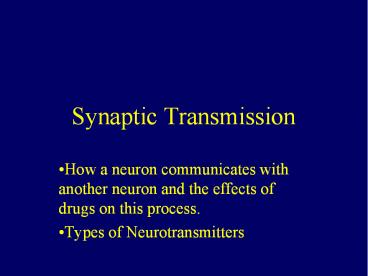Synaptic Transmission - PowerPoint PPT Presentation
Title: Synaptic Transmission
1
Synaptic Transmission
- How a neuron communicates with another neuron and
the effects of drugs on this process. - Types of Neurotransmitters
2
Neuron to Neuron
- Axons branch out and end near dendrites of
neighboring cells - Axon terminals are the tips of the axons
branches - A gap separates the axon terminals from dendrites
- Gap is the Synapse
Click on video to review (if time allows)
3
(No Transcript)
4
Steps to Synaptic Transmission
- Action Potential causes synaptic vesicle to open
- Neurotransmitter (NT) released into synapse
- NT locks onto receptor molecule in postsynaptic
membrane (on receiving dendrite) - Receptor site opens and allows positive sodium
ions to enter the dendrite triggering action
potential.
5
(No Transcript)
6
(No Transcript)
7
Excitatory and Inhibitory Messages
- Excitatory messageincreases the likelihood that
the postsynaptic neuron will activate - Inhibitory messagedecreases the likelihood that
the postsynaptic neuron will activate.
8
Locks and Keys
- Neurotransmitter molecules have specific shapes
- Receptor molecules have binding sites
- When NT binds to receptor, ions enter
9
Neurotransmitters Bonding at a Receptor Site
10
Drugs Impact on Synaptic Transmission
11
Some Drugs Work on Receptor Sites
- Some Drugs are shaped extremely similar to a NT
and like a copy of a key unlock the receptor site - Agonists fit receptor well and mimic the NT
causing Action Potential - e.g., nicotine
12
Some Drugs Work on Receptor Sites
- Some drugs are shaped like neurotransmitters but
do NOT unlock the receptor site thus blocking it
from receiving natural NT. - Antagonists fit the receptor but poorly and
block the NT stopping the action potential
message - e.g., beta blockers
13
Natural Neurotransmitters are like a key to a
lock. They bond to the receptor site unlocking
it
14
Antagonist Drugs block the receptor site. Like a
key in the wrong lock, they wont open the
door/receptor site.
15
Agonist drugs mimic neurotransmitters and open
the receptor sitejust like a copied key will
unlock a door.
16
Types of Neurotransmitters
- Acetylcholine
- Serotonin
- Norepinephrine
- Dopamine
- Endorphins
- GABA
- Glutamate
17
Acetylcholine (Ach)
- Excitory neurotransmitter found in neuromuscular
junctions - Involved in muscle contractions
- Involved in learning and memory
18
Disruption of Acetylcholine Functioning
- Curareblocks ACh receptors
- paralysis results
- Nerve gases and Black Widow spider venom mimics
Ach too much ACh leads to severe muscle spasms
and possible death
19
Disruptions in ACh Functioning
- Cigarettesnicotine works on ACh receptors by
mimicking ACh - can artificially stimulate skeletal muscles,
leading to slight trembling movements
20
Alzheimers Disease
- Deterioration of memory, reasoning, and language
skills - Low levels of Ach found in those with Alzheimers
disease - Symptoms may be due to loss of ACh neurons
Click on video to view (7 min)
21
Serotonin
- Involved in mood, hunger, sleep
- Low levels involved in depression
- Prozac works by keeping serotonin in the synapse
longer, giving it more time to exert an effect
(re-uptake inhibitor)
22
Norepinephrine
- Arousal, learning memory
- Fight or flight response
- Low levels found in those with depression.
23
Dopamine
- Involved in movement, attention and learning.
Also pleasure rewarding sensations. - Too much Dopamine involved in schizophrenia.
Thorazine blocks it. - Drugs like cocaine and nicotine mimic dopamine
- Loss of dopamine-producing neurons is cause of
Parkinsons disease. Give L-Dopa (converts to
dopamine) to combat this.
24
Parkinsons Disease
- Results from loss of dopamine-producing neurons
in the substantia nigra - Symptoms include
- difficulty starting and stopping voluntary
movements - tremors at rest
- stooped posture
- rigidity
- poor balance
25
Parkinsons Disease
- Treatments
- L-dopa
- transplants of fetal dopamine-producing
substantia nigra cells - adrenal gland transplants
- electrical stimulation of the thalamus has been
used to stop tremors
26
GABA
- Inhibition (slows down) of brain activity
- Influences anxiety when in low supply.
- Antianxiety medicationss Valium Xanax increase
GABA activity slowing down the brain. - Alcohol mimics GABA
- Plays a dual role in sleep day excites the
brain, night slows down the brain. - Huntingtons disease involves loss of neurons in
striatum that utilize GABA - Symptoms
- jerky involuntary movements
- mental deterioration
27
Glutamate
- Major excitatory neurotransmitter
- Too much glutamate (and too little GABA)
associated with epileptic seizures
28
Endorphins
- Control pain and pleasure by blocking the
neurotransmitter Substance P which transmits pain
messages to the brain. - Released in response to pain
- Morphine and codeine work on endorphin receptors
involved in healing effects of acupuncture - Runners high feeling of pleasure after a long
run is due to heavy endorphin release
29
Summary
- Neuron structure
- Action potentials
- Synapse
- Neurotransmitters
- Receptors and ions
- Agonists and antagonists































